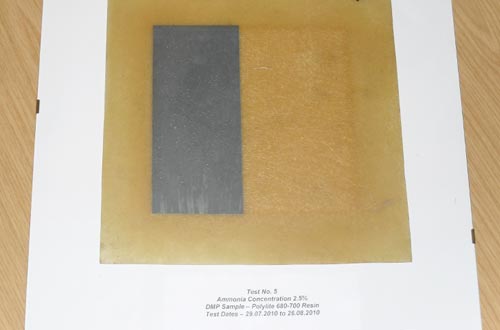RESEARCH AND DEVELOPMENT
AMMONIA TESTS
GRP panels were designed for use in an industrial composting silo, which would mean exposing the composite materials to an ammonia rich atmosphere of up to 80°C in temperature. For interest, the material being composted consists of vegetable and animal matter, with the animal hair predominantly responsible for the ammonia build up.
In the absence of any previous data, a test was instigated in order to prove the suitability of the chosen polyester resin for this atmosphere. The tests were classed as extreme due to the high density of ammonia present, up to 35%.
For the test itself, a sealed GRP test box was made that would house the ammonia solution and also contain the GRP test pieces. This test box was then placed inside a general purpose laboratory oven.
Over a four week period the test pieces were exposed to a daily cycle of heat and ammonia exposure, with a visual survey of the test pieces conducted daily. Several test pieces were created and exposed to varying levels of ammonia concentration. Following the ammonia and heat cycles, the test pieces were then subject to a standard tensile test to evaluate any loss in material strength.
The tests concluded that the selected resin was satisfactory for purpose and even after high heat and ammonia exposure there was no reduction in material strength. Due to the hazards presented by the ammonia, the test was carried out to a strict method statement and a full risk assessment was carried out before commencing the tests. Chemical resistant PPE was used throughout the testing.
MORE RESEARCH AND DEVELOPMENT
AMMONIA TEST










